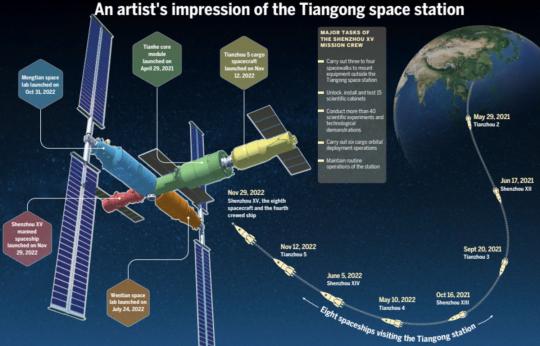
(CHINA DAILY)
Completion of Tiangong orbital hub highlight of busy year
China's space industry had a busy year in 2022, the highlight of which was completion of one of the world's largest and most sophisticated orbiting infrastructures, the Tiangong space station.
After traveling for 15 months in low orbit, about 400 kilometers above the Earth, Tianhe, the space station's core module, received its first long-term companion — the Wentian lab module — in late July.
Wentian lifted off on a Long March 5B heavy-duty rocket from the Wenchang Space Launch Center in Hainan province to become Tiangong's first scientific component.
Weighing 23 metric tons and with a length of 17.9 meters, Wentian carries eight scientific cabinets, which are mainly used for biological and life science studies, but can also support research on the growth, aging and genetic traits of plants, animals and microbes in space.
Wentian's exterior is equipped with extravehicular payload adapters that carry scientific equipment for experiments requiring exposure to space, cosmic rays, vacuums and solar winds.
In addition to its scientific functions, Wentian acts as a backup control station to the Tianhe module in case of emergencies or malfunctions. It has the same flight-control devices as Tianhe, as well as three separate sleeping quarters and an area for personal hygiene, enabling the entire Tiangong station to be operated via Wentian if necessary.
In late October, the second lab module — Mengtian — lifted off on another Long March 5B rocket to dock with Tianhe.
Mengtian, the world's largest single-body spacecraft in active service, carries 13 scientific cabinets for use in microgravity studies and experiments in fluid physics, materials science, combustion science and fundamental physics. It also has 37 extravehicular payload adapters.
A major technical feature of the spacecraft is that it can move scientific apparatus out of the Tiangong station — without any manual labor from the astronauts — to conduct extravehicular experiments, before returning with the apparatus.
Moreover, Mengtian's designers said it can send miniature spacecraft, such as CubeSats, into orbit. The addition of Mengtian marked the end of the in-orbit assembly process for the Tiangong station.
Four teams of astronauts have lived and worked on the space station, which now consists of the Tianhe module, the Wentian and Mengtian science capsules, the Shenzhou XV spacecraft and the Tianzhou 5 cargo ship.
The current crew — the three members of the Shenzhou XV mission — arrived at the station in late November. They worked with the three Shenzhou XIV astronauts, who had been aboard the station for almost six months, for four days before the latter team returned to Earth.
The Shenzhou XV crew is scheduled to remain at the space station until May, before being relieved by members of the Shenzhou XVI mission.
In his annual New Year address on Dec 31, President Xi Jinping announced that the Tiangong station had been completed.
According to the China Manned Space Agency, Tiangong will serve as a national space-based platform for science and technology. It is expected to remain in orbit for more than 10 years, and will be open to astronauts from other countries in the near future.
Yang Yuguang, a senior space industry observer in Beijing and vice-chair of the International Astronautical Federation's space transportation committee, said that although the Tiangong station is much smaller than the International Space Station, it is more cost-effective.
"We spent much less than the sum needed to build and run the ISS. The steps we took (to construct the Tiangong station) were also simpler and easier than those required for the ISS. Nevertheless, Tiangong has a pretty strong capability to perform scientific experiments and technological tests through its cutting-edge equipment," Yang said.
Starting this year, members of the third group of Chinese astronauts are scheduled to take part in flights, officials from the China Manned Space Agency said. The 18 new astronauts — 17 men and one woman — are in three groups: seven spacecraft pilots, seven spaceflight engineers and four payload specialists.
They are undergoing systematic training at the Astronaut Center of China in Beijing, before being certified for spaceflights.


